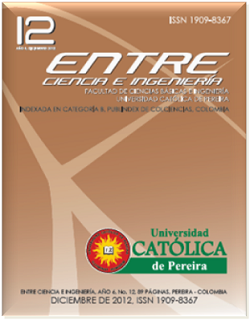Performance Evaluation of Modulated Markov Process Models for Traffic on IEEE 802.11 Networks – Study of Case for the QRD Network
Keywords:
QRD, WLAN, MAC, time slot, contention window, Markov chains, traffic, correlation, goodness of fit test, snniferAbstract
This paper evaluates the performance of Markov modulated processes models in IEEE 802.11 networks. This study is focused on the “Quindio Región Digital” (QRD) network. Performance evaluation of the traffic models is performed in three stages. In the first stage, we obtain the statistical characteristics of the current traffic on the QRD network. In the second stage, the most suitable traffic models are selected for the current characteristics of the QRD network such as
out-of-saturation operation and management of heterogeneous traffic. In the third stage, we define a performance metric that is used to evaluate the traffic patterns through simulation.
References
E. Astaiza H., H. Bermudez O and D. Salgado, “Performance Evaluation of Selfsimilar Models for Traffic on IEEE 802.11 Networks - Stydy of Case for the QRD Network,” ITECKNE, vol. 9, no. 2, pp. 33 - 39, 2012.
Y. Tay and K. Chua, “A Capacity Analysis for the IEEE802.11 MAC Protocol,” Wireless Networks 7, pp. 159-171, 2001.
P802.11, IEEE Standard for Wireless LAN Medium Access Control (MAC) and Physical Layer (PHY) Specifications, 1997.
G. Bianchi, “Performance Analysis of the IEEE 802.111Distributed Coordination Function,” IEEE Journal on SelectedAreas in Communications, vol. Vol. 18, no. No. 3, 2000.
U. Lamping, R. Sharpe and E. Warnicke, Wireshark User’s Guide, Wireshark 1.4, 2004.
E. Astaiza, H. F. Bermúdez and P. A. Gutiérrez, Simulación De Sistemas De Telecomunicaciones, Armenia: Ed Padilla Bejarano , Ferney, 2007.
B. Bellalta, M. Oliver, M. Meo and M. Guerrero, “A Simple Model of the IEEE 802.11 MAC Protocol with Heterogeneous Traffic Flows,” Belgrade, Serbia and Montenegro, 2005.
K. Duffy, D. Malone and D. J. Leith, “Modeling the 802.11 Distributed Coordination Function in Non-Saturated Conditions,” IEEE COMMUNICATIONS LETTERS, vol. 9, no. 8, 2005.
B. I. Villy, TELETRAFFIC ENGINEERING HANDBOOK, Technical university of Denmark, 2001.
J. Hayes F. and T. Ganesh Babu, MODELING AND ANALYSIS OF TELECOMUNICATIONS NETWORKS, New Jersey: John wiley & sons, inc, 2004.
I. S. Oleg, M. S. Sergey and V. O. Andrey, SELF-SIMILAR PROCESSES IN TELECOMMUNICATION, John wiley & sons, ltd, 2007.
G. Xiao-hu, Y. Yang, W. Cheng-Xiang, L. Ying-Zhuang, L. Chuang and X. Lin, Characteristics analysis and modeling of frame traffic in 802.11 wireless networks, John Wiley& Sons, Ltd, 2009.
G. Fiche and G. Hebuterne, “Communicating Systems & Networks: Traffic & Performance,” London and Sterling, VA., 1988.
W. Grote, C. Ávila and A. Molina, “ANÁLISIS DE MÁXIMO DESEMPEÑO PARA WLAN OPERANDOA TASAS FIJAS O ADAPTIVAS USANDO EL ESTÁNDAR IEEE 802.11 a/b/g,” Revista chilena de ingeniería, vol. 15, no. 3, 2007.
D. P. Pezaros, M. Sifalakis and D. Hutchison, “On the Long-Range Dependent Behavior of Unidirectional Packet Delay of Wireless Traffic,” in IEEE Global Telecommunications Conference (IEEE GLOBECOM), Washington, DC., 2007.
A. Reyes L., “MODELADO DE TRÁFICO DECLIENTES WWW,” Universidad de Málaga, Málaga, 2001.








 Revista Entre Ciencia e Ingeniería
Revista Entre Ciencia e Ingeniería .png) entrecei@ucp.edu.co
entrecei@ucp.edu.co.png) ISSN (Impreso) 1909-8367 - ISSN (En Línea) 2539-4169
ISSN (Impreso) 1909-8367 - ISSN (En Línea) 2539-4169 Attribution-NonCommercial 4.0 International (CC By-NC 4.0)
Attribution-NonCommercial 4.0 International (CC By-NC 4.0)
.png) Carrera 21 No. 49-95 Av. de las Américas, Pereira, Risaralda, Colombia
Carrera 21 No. 49-95 Av. de las Américas, Pereira, Risaralda, Colombia